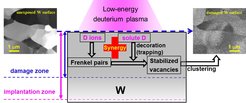A novel damaging mechanism for tungsten
A potentially novel damaging mechanism during the interaction of hydrogen plasmas with tungsten surfaces was discovered in experiments performed at IPP.

Applying a new low-energy argon-sputter depth profiling method with significantly improved depth resolution to tungsten (W) surfaces exposed to a deuterium (D) plasma at 300 K, a 10 nm thick D-supersaturated surface layer (DSSL) with an unexpectedly high D concentration of ~10 at.% after irradiation with an ion energy of 215 eV was found. Additional investigations by scanning electron microscopy (SEM) revealed that the W lattice within this DSSL is highly distorted, although the applied ion energy is too low to produce classical radiation damage (i.e. producing permanent displacement of lattice atoms). This strong damage is explained by the synergistic interaction of energetic D ions and solute D atoms with the W lattice. Solute D atoms prevent the recombination of vacancies with interstitial W atoms, which are produced by collisions of energetic D ions with W lattice atoms (Frenkel pairs). In the absence of a sufficiently high D concentration the majority of the produced Frenkel pairs would immediately recombine. It is conceivable that a comparable stabilisation of lattice defects by solute hydrogen isotopes could also be active in the damaging of wall materials in fusion devices and such enhance the fuel retention level.
The results of this study were recently published in Nuclear Fusion:
L. Gao et al., Nuclear Fusion 57, 016026 (2017),
http://dx.doi.org/10.1088/0029-5515/57/1/016026
